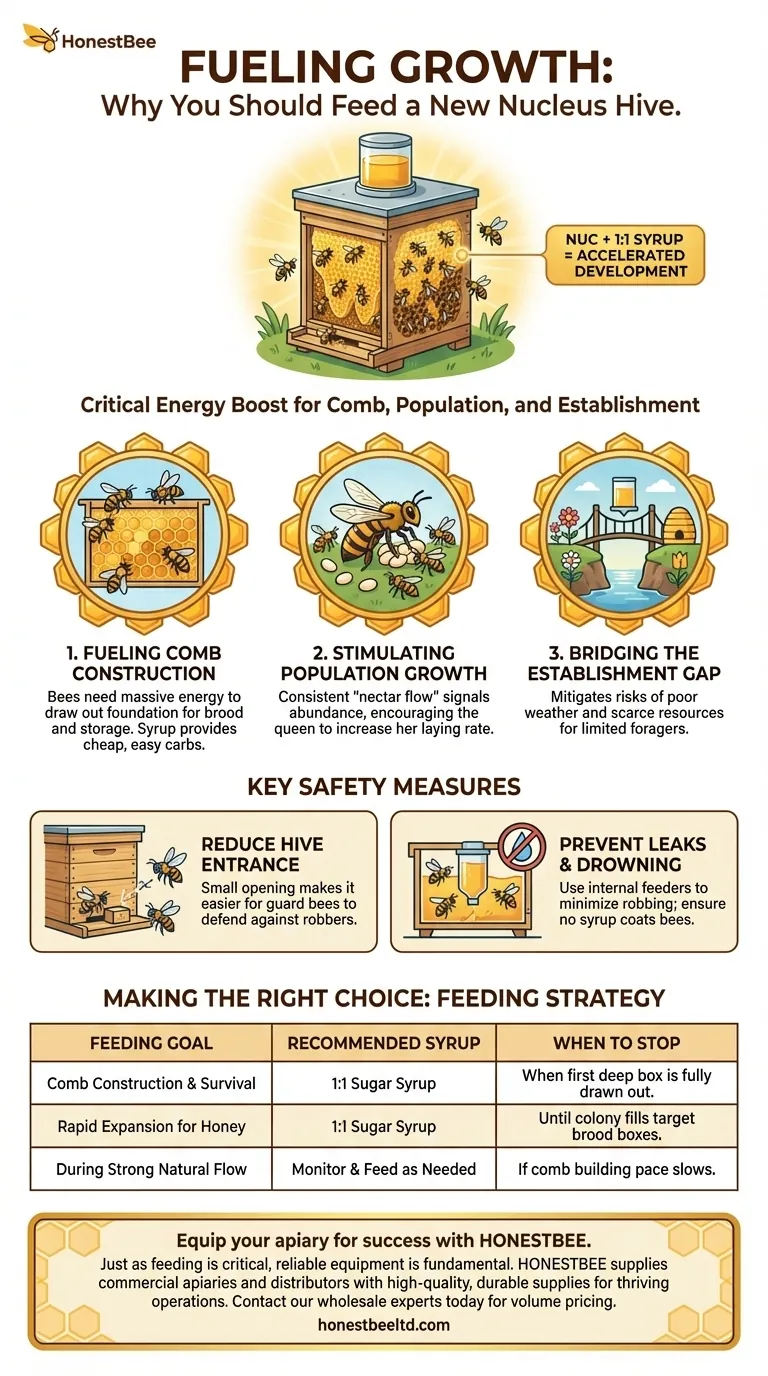Yes, you should almost always feed a new nucleus hive after installation. This practice provides the critical energy boost a small, developing colony needs to rapidly build wax comb, expand its population, and establish itself in the new hive. Failing to feed is one of the most common reasons a new colony struggles to thrive.
A nucleus hive is a small, vulnerable colony focused on one thing: growth. Providing a consistent source of sugar syrup is not just about preventing starvation; it's about providing the fuel they need to accelerate their construction and population boom, transforming them into a self-sufficient hive.

Why Feeding a New Nuc is Crucial
A nucleus hive, often called a "nuc," is essentially a starter colony. It has a queen, a few frames of brood, and a small population of worker bees. Your primary goal is to help them fill out a full-sized hive box as quickly and safely as possible.
Fueling Comb Construction
Bees consume enormous amounts of energy to produce wax. They must draw out the foundation on the empty frames in their new hive before the queen has space to lay eggs and workers have space to store pollen and nectar.
A steady supply of 1:1 sugar syrup (one part sugar to one part water) provides the cheap, easy-to-access carbohydrates they need for this intensive construction project.
Stimulating Population Growth
A consistent "nectar flow," even an artificial one from a feeder, signals to the queen that resources are abundant. This encourages her to increase her laying rate, which is the engine for the colony's population growth.
More bees lead to more foragers, more comb builders, and a stronger, healthier colony that can eventually sustain itself.
Bridging the Establishment Gap
A new nuc has a limited number of forager bees. If the weather is poor or natural nectar sources are scarce, the colony can quickly run out of the resources needed for its expansion.
Supplemental feeding ensures they have a reliable food source inside the hive, mitigating the risks of weather and variable floral resources while they get established.
Key Safety Measures to Implement
Feeding a small colony comes with risks. A weak hive emitting the smell of sugar syrup can be an irresistible target for stronger hives, wasps, or ants. These two steps are non-negotiable.
Reduce the Hive Entrance
Immediately after installation, you must reduce the hive entrance to a small opening, typically 1-2 inches wide.
A smaller entrance is much easier for the nuc's limited number of guard bees to defend against robbers who are attracted by the feeder.
Prevent Leaks and Drowning
Always use an internal feeder for a new nuc to minimize robbing from outsiders. Ensure your feeder is set up correctly and does not leak.
A leaky feeder can coat bees in syrup, and a poorly designed one can lead to many bees, including the queen, drowning. This can be a fatal setback for a small colony.
Making the Right Choice for Your Hive
Your decision to feed should be guided by the colony's progress and your ultimate goals.
- If your primary focus is survival and establishment: Feed a 1:1 sugar syrup consistently until the bees have drawn out all the frames in their first deep hive body.
- If you are installing during a strong natural nectar flow: You may be able to feed less, but still monitor them closely to ensure they are building comb at a steady pace.
- If your primary focus is rapid expansion for a honey crop: Continuous feeding is the fastest way to get them to build out their brood boxes so they are at full strength when the main nectar flow begins.
Properly feeding your new nucleus hive is one of the most effective actions you can take to transform it into a thriving, productive colony.
Summary Table:
| Feeding Goal | Recommended Syrup | When to Stop |
|---|---|---|
| Comb Construction & Survival | 1:1 Sugar Syrup | When first deep box is fully drawn out |
| Rapid Expansion for Honey | 1:1 Sugar Syrup | Until colony fills target brood boxes |
| During Strong Natural Flow | Monitor & Feed as Needed | If comb building pace slows |
Equip your apiary for success with HONESTBEE.
Just as proper feeding is critical for a new nucleus hive, having the right, reliable equipment is fundamental for long-term beekeeping success. HONESTBEE supplies commercial apiaries and beekeeping equipment distributors with the high-quality, durable supplies needed to build and maintain thriving operations.
Let us help you strengthen your business foundation. Contact our wholesale experts today to discuss your equipment needs and volume pricing.
Visual Guide

Related Products
- Classic Boardman Entrance Bee Feeder Hive Front Feeding Solution
- HONESTBEE Entrance Bee Feeder Professional Hive Nutrition Solution for Beekeeping
- HONESTBEE Entrance Bee Feeder Efficient Hive Front Liquid Feeding Solution for Beekeeping
- HONESTBEE Professional Entrance Bee Feeder Hive Nutrition Solution
- Professional Hive Front Entrance Bee Feeder
People Also Ask
- What are the different types of honey bee feeders? Choose the Right Feeder for Your Hive
- What is the best feeder for bees? Choose the Right Feeder for Your Hive's Success
- What is a common problem with hive front feeders? Avoid Robbing Frenzies and Protect Your Hives
- What types of bee feeders are available for beginners? Start with the Simple Entrance Feeder
- How can a Boardman Feeder be used to provide water to bees? Avoid These Critical Risks to Your Hive



















